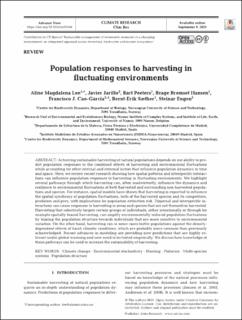| dc.contributor.author | Lee, Aline Magdalena | |
| dc.contributor.author | jarillo, j | |
| dc.contributor.author | Peeters, Bart | |
| dc.contributor.author | Hansen, Brage Bremset | |
| dc.contributor.author | cao-garcia, francisco | |
| dc.contributor.author | Sæther, Bernt-Erik | |
| dc.contributor.author | Engen, Steinar | |
| dc.date.accessioned | 2022-03-08T09:54:52Z | |
| dc.date.available | 2022-03-08T09:54:52Z | |
| dc.date.created | 2021-06-08T15:26:59Z | |
| dc.date.issued | 2021 | |
| dc.identifier.issn | 0936-577X | |
| dc.identifier.uri | https://hdl.handle.net/11250/2983712 | |
| dc.description.abstract | Achieving sustainable harvesting of natural populations depends on our ability to predict population responses to the combined effects of harvesting and environmental fluctuations while accounting for other internal and external factors that influence population dynamics in time and space. Here, we review recent research showing how spatial patterns and interspecific interactions can influence population responses to harvesting in fluctuating environments. We highlight several pathways through which harvesting can, often inadvertently, influence the dynamics and resilience to environmental fluctuations of both harvested and surrounding non-harvested populations and species. For instance, spatial models have shown that harvesting is expected to influence the spatial synchrony of population fluctuations, both of the harvested species and its competitors, predators and prey, with implications for population extinction risk. Dispersal and interspecific interactions can cause responses to harvesting in areas and species that are not themselves harvested. Harvesting that selectively targets certain groups of individuals, either intentionally or through for example spatially biased harvesting, can amplify environmentally induced population fluctuations by biasing the population structure towards individuals that are more sensitive to environmental variation. On the other hand, harvesting can in some cases buffer populations against the density-dependent effects of harsh climatic conditions, which are probably more common than previously acknowledged. Recent advances in modeling are providing new predictions that are highly relevant under global warming and now need to be tested empirically. We discuss how knowledge of these pathways can be used to increase the sustainability of harvesting. | en_US |
| dc.language.iso | eng | en_US |
| dc.publisher | Inter Research | en_US |
| dc.relation.uri | https://doi.org/10.3354/cr01656 | |
| dc.rights | Navngivelse 4.0 Internasjonal | * |
| dc.rights.uri | http://creativecommons.org/licenses/by/4.0/deed.no | * |
| dc.title | Population responses to harvesting in fluctuating environments | en_US |
| dc.type | Peer reviewed | en_US |
| dc.type | Journal article | en_US |
| dc.description.version | publishedVersion | en_US |
| dc.source.journal | Climate Research (CR) | en_US |
| dc.identifier.doi | 10.3354/cr01656 | |
| dc.identifier.cristin | 1914606 | |
| dc.relation.project | Norges forskningsråd: 223257 | en_US |
| dc.relation.project | Norges forskningsråd: 276080 | en_US |
| cristin.ispublished | false | |
| cristin.fulltext | original | |
| cristin.qualitycode | 1 | |

